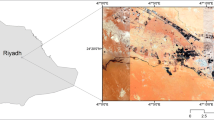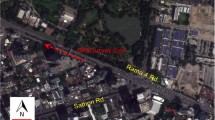Abstract
In coal mines abandoned works or voids at shallow depth, might be a potential hazard and therefore, such areas are considered for redevelopment. As voids and fractures accumulate groundwater which may be hazardous for the mines work. Subsidence, fire, flooding and some other kinds of environmental hazards related to shallow coal works, necessitate for better understanding of voids and their interpretation for Ground Penetrating Radar (GPR) data. Whereas, in civil engineering, GPR is used for detection of the buried pipe, however, it becomes difficult to differentiate betweem the pipes used for water supply and for electrical cable. In order to better interpretation of voids and buried pipes we present a finite-difference time-domain (FDTD) solution based on Maxwell’s equations that allows accounting for the frequency dependence of the dielectric permittivity and electrical conductivity of many near-surface materials. The algorithm and the results presented here, however, offer the perspective to improve some of these inherent problems and thus help to make 2-D structure a more reliable and effective tool for probing the shallow subsurface. Also it is found that the different dispersion mechanisms cause significant amplitude and phase differences, which may be relevant to amplitude variation with offset (AVO) and stratigraphic investigations using Ground Penetrating Radar.
Similar content being viewed by others
References
Annan, A.P. (1997) Ground Penetrating Radar works notes-case studies. Sensors and software Inc, Mississauga, Ontario, pp.7–8.
Bano, M., Marthelot, J.M. and Pivot, F. (1999) Modeling and filtering of surface scattering in ground penetrating radar waves, First Break 17.6, pp.215–222.
Bergmann, T., Blanch, J.O., Robertsson, J.O.A. and Holliger, K. (1999) A simplified Lax-Wendroff correction for staggered grid FDTD modeling of electromagnetic wave propagation in frequency dependent media. Geophysics, v.64, pp.1369–1377.
Bergmann, T., Robertsson, J.O.A. and Holliger, K. (1996) Numerical properties of staggered finite-difference solutions for ground penetrating radar modeling. Geophys. Res. Lett., v.23, pp.45–48.
Bursink, M.L., Haeni, F.P., Lane Jr., J.W. and Versteeg, R.J. (2000) Evaluation of Ground Penetrating Radar to Detect Free-Phase Hydrocarbon in Fractured rocks — Results of Numerical Modelling and Physical Experiments, Ground Water, v.36, pp.929–938.
Chakraborty, S. and Nath, S.K. (2004) Seismic Transmission and electrical resistivity tomography for the delineation of mine galleries in Raniganj Coalfield, India. First Break, v.22, pp.35–51.
Cormier, V.F. and Xu, L. (1998) Seismic attenuation of the inner core: viscoelastic or stratigraphic? Geophys. Res. Lett., v.25, pp.4019–4022.
Dablain, M.A. (1986) The application of high-order differencing to the scalar wave equation. Geophysics, v.51, pp.127–139.
Durran, D.R. (1999) Numerical methods for wave equations in geophysical fluid dynamics. Springer Publ. Co., Inc.
Holliger, K. and Bergmann, T. (2002) Numerical modeling of borehole georadar data. Geophysics, v.67, pp.1249–1257.
Irving, J. and Knight, R. (2006) Numerical modeling of ground-penetrating radar in 2-D using MATLAB. Computers & Geosciences, v.32, pp.1247–1258.
Mcmechan, A. and Wang, D. (2002) Finite-difference modeling of borehole ground penetrating radar. Jour. Appld. Geophys., v.49, pp.111–127.
Sato, M. and Thierbach, R. (1991) Analysis of a borehole radar in cross-hole mode. IEEE Trans. Geosci. Remote Sens., v.29, pp.899–904.
Singh, K.K.K. and Chauhan, R.K.S. (2002) Exploration of subsurface strata conditions for limestone mining area in India with Ground Penetrating Radar. Internat. Jour. Geosci., Environ. Geol., v.41, pp.966–969.
Telford, W.M., Geldart, L.P. and Sherif, R.E. (2004) Applied Geophysics. 2nd edition, pp.306–310.
Toshioka, T., Tsuchida, T. and Sasahara, K. (1995) Application of GPR to detecting and mapping cracks in rock slopes. Jour. Appld. Geophys., v.33, pp.119–124.
Vasco, D.W., Peterson Jr., J.E. and Majer, E.L. (1996) A simultaneous inversion of seismic traveltimes and amplitudes for velocity and attenuation. Geophysics, v.61, pp.1738–1757.
Yee, K.S. (1966) Numerical solution of initial boundary value problems involving Maxwell’s equations in isotropic media. IEEE Ant. Propag., v.14, pp.302–307.
Author information
Authors and Affiliations
Corresponding author
Rights and permissions
About this article
Cite this article
Singh, K.K.K., Kumar, I. & Singh, U.K. Interpretation of voids or buried pipes using Ground Penetrating Radar modeling. J Geol Soc India 81, 397–404 (2013). https://doi.org/10.1007/s12594-013-0050-6
Received:
Accepted:
Published:
Issue Date:
DOI: https://doi.org/10.1007/s12594-013-0050-6




